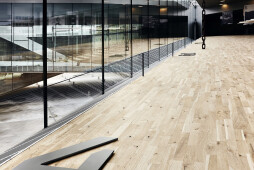Collaboration:BIG with Kossmann.dejong, Rambøll, Freddy Madsen andKiBiSi
The new Danish Maritime Museum is a subterranean museum built around a dry dock adjacent to Kronborg Castle of Hamlet fame. For a century the site was a shipyard bustling with vessels and machinery, and the dry dock that now forms the centrepiece of the museum’s underground building is a legacy of this yard. Yet until recently, the dock lay in a state of neglect in a decayed post-industrial landscape, a desolate and rather ugly concrete relic of a lost industry. Due to the UNESCO World Heritage status of Kronborg Castle, the museum, formerly located within the castle’s walls, was evicted in order to restore the castle’s original interiors. It was decided that the museum’s program should be housed inside the dry dock next to the castle. Contrary to its name, the dry dock was full of water and posed severe geotechnical challenges. To keep the dock walls standing, one would have to build a fortifying new dock inside the dock, or install new dock walls around the dock. The dock itself was a majestic structure, 150 metres long and 25 metres wide, in the shape of a hull. It would be a pity to drown this industrial cathedral in museum program, or even to bury it under faux fortifications.
In 2004, the museum board gained the support of four major shipping companies to finance an architectural competition for a museum in the dry dock, after which eleven different foundations generously supported the project through to its completion. Initially the competition brief contained several dilemmas. Firstly, although the museum was not allowed to protrude above ground level to preserve the view to Kronborg Castle, some sort of iconic roof structure over the dock was expected to maximise the museum’s attractiveness. Secondly, the museum program was twice the footprint of the dock, forcing the architect to build on two levels, thus turning the museum into a concealed claustrophobic basement with no view. As the law requires all workspaces to have daylight and views, the staff would then have to be located in another building, disconnected from the museum. The winning architect’s idea of fitting the museum around the dry dock rather than inside and leaving the dry dock as a void space traversed by bridges was the most radical of the five proposals but also a clear solution to the inherent dilemmas of the competition.
To overcome the aforementioned geotechnical challenges, the architect proposed to install new walls at a distance around the old dock to maintain its structural integrity and place the museum in the space between the new and old dock walls, essentially wrapping it around the existing dry dock like a doughnut. A series of three two-level steel bridges span the dry dock, serving as short-cuts to different sections of the museum. A sloping zigzag bridge spanning the entire dry dock navigates visitors to the main entrance. This bridge creates a dynamic tension between old and new as visitors descend into the museum space overlooking the majestic surroundings above and below ground, while Denmark’s maritime history unfolds in a continuous motion. All floors—connecting exhibition spaces with the auditorium, classroom, offices, café and the dock floor within the museum—slope gently, creating dramatic and sculptural spaces. By arranging the galleries in a continuous loop around the dry dock walls and leaving the dock open, the dock becomes the centrepiece of the exhibition—an open, outdoor area where visitors experience the size of the ship.
Despite Denmark’s prominent global maritime presence, the shipping industry can seem almost invisible to those not directly involved in its development and day-to-day operations. How fitting, then, that this under-recognized economy should be represented by a building that also hides in plain sight, yet represents a remarkable feat in architecture, civil and structural engineering. Completed in October 2013, the newly opened Danish Maritime Museum has proven itself with an understanding of the unique historic and spatial context it is in as it seeks to reflect Denmark's historical and contemporary role as one of the world's leading maritime nations. The museum is open to the public for outdoor activities, exhibitions and events, making it a cultural hub in the region throughout the year. The museum demonstrates that by proactively cross-breeding public infrastructure—a dry dock—with social programs, we can inject new urban life forms into the heart of our cities . . . any city that has lost its former industries and is looking for ways to look forward without forgetting its past.




































































